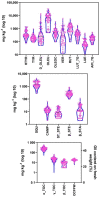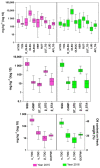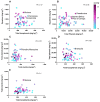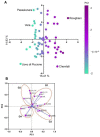Bioactive Compound Profiling of Olive Fruit: The Contribution of Genotype
- PMID: 35453357
- PMCID: PMC9032303
- DOI: 10.3390/antiox11040672
Bioactive Compound Profiling of Olive Fruit: The Contribution of Genotype
Abstract
The health, therapeutic, and organoleptic characteristics of olive oil depend on functional bioactive compounds, such as phenols, tocopherols, squalene, and sterols. Genotype plays a key role in the diversity and concentration of secondary compounds peculiar to olive. In this study, the most important bioactive compounds of olive fruit were studied in numerous international olive cultivars during two consecutive seasons. A large variability was measured for each studied metabolite in all 61 olive cultivars. Total phenol content varied on a scale of 1-10 (3831-39,252 mg kg-1) in the studied cultivars. Squalene values fluctuated over an even wider range (1-15), with values of 274 to 4351 mg kg-1. Total sterols ranged from 119 to 969 mg kg-1, and total tocopherols varied from 135 to 579 mg kg-1 in fruit pulp. In the present study, the linkage among the most important quality traits highlighted the scarcity of cultivars with high content of at least three traits together. This work provided sound information on the fruit metabolite profile of a wide range of cultivars, which will facilitate the studies on the genomic regulation of plant metabolites and development of new olive genotypes through genomics-assisted breeding.
Keywords: antioxidant; genotype effect; oleocanthal; oleuropein; olive cultivars; olive fruit; squalene; sterols; verbascoside; α-tocopherol.
Conflict of interest statement
The authors declare no conflict of interest. The funders had no role in the design of the study; in the collection, analyses, or interpretation of data; in the writing of the manuscript; or in the decision to publish the results.
Figures







References
-
- Lozano-Castellón J., López-Yerena A., Rinaldi de Alvarenga J.F., Romero del Castillo-Alba J., Vallverdú-Queralt A., Escribano-Ferrer E., Lamuela-Raventós R.M. Health-promoting properties of oleocanthal and oleacein: Two secoiridoids from extra-virgin olive oil. Crit. Rev. Food. 2020;60:2532–2548. doi: 10.1080/10408398.2019.1650715. - DOI - PubMed
-
- Guclu G., Kelebek H., Selli S. Antioxidant activity in olive oils. In: Preedy V.R., Watson R.R., editors. Olives and Olive Oil in Health and Disease Prevention. 2nd ed. Elsevier Inc.; London, UK: 2021. pp. 313–325.
-
- Dabbou S., Chehab H., Faten B., Dabbou S., Esposto S., Selvaggini R., Taticchi A., Servili M., Montedoro G.F., Hammami M. Effect of three irrigation regimes on Arbequina olive oil produced under Tunisian growing conditions. Agric. Water Manag. 2010;97:763–768. doi: 10.1016/j.agwat.2010.01.011. - DOI
-
- Cayuela J.A., García J.F. Nondestructive measurement of squalene in olive oil by near infrared spectroscopy. LWT. 2018;88:103–108. doi: 10.1016/j.lwt.2017.09.047. - DOI
Grants and funding
LinkOut - more resources
Full Text Sources

